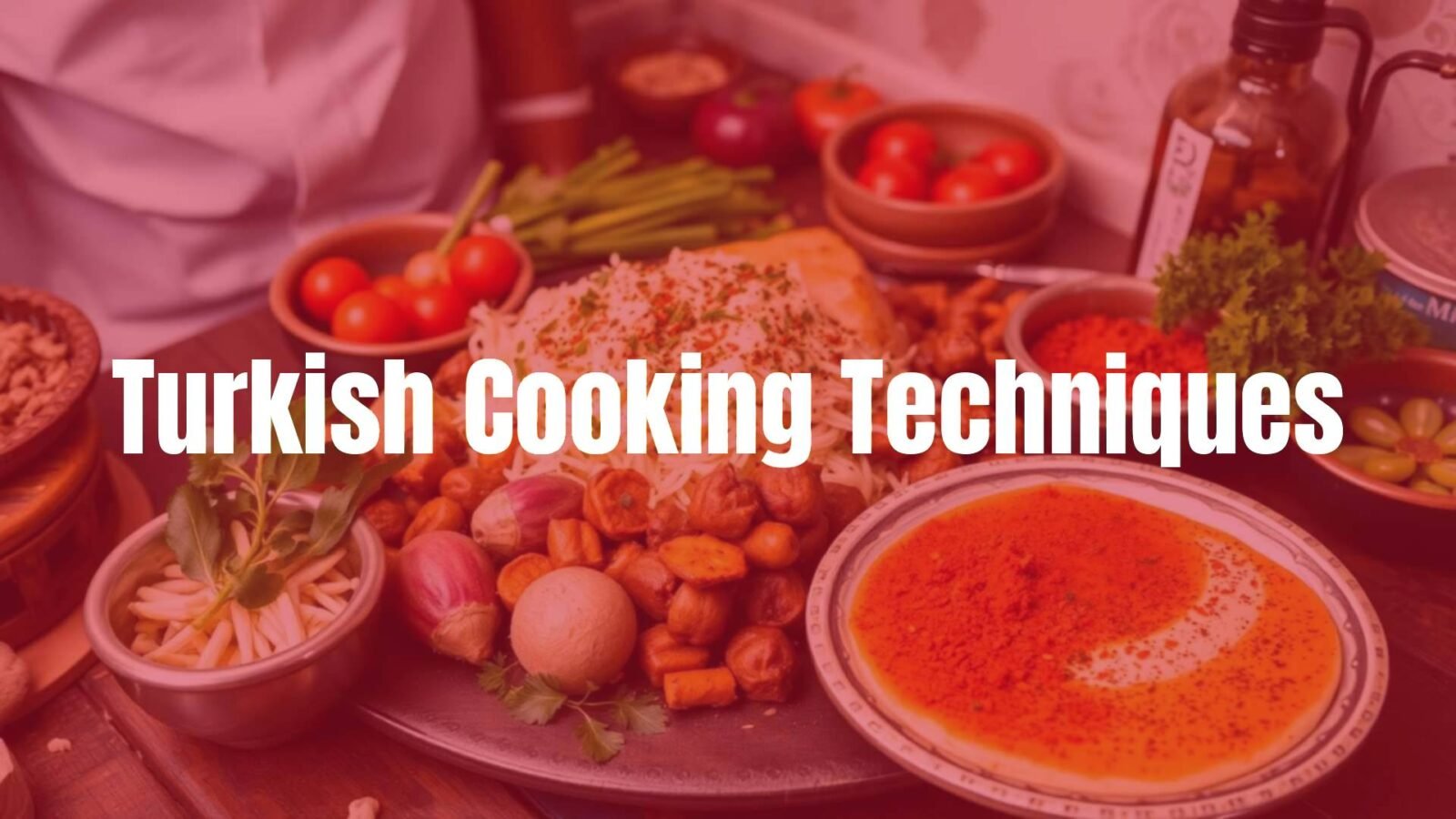Turkish cooking techniques are built on rich traditions that have grown and changed over many centuries. They show Turkey’s history-from the days of the Ottoman Empire to the many regions that make up modern Turkey. Turkish cuisine isn’t just about recipes; it relies on careful use of different cooking methods. These bring out deep flavors, keep food nutritious, and put the focus on fresh, seasonal food. The main goal is to make food that is balanced, tasty, and healthy for everyone to enjoy.
Whether it’s the smoky taste of grilled meats or the soft, slow-cooked vegetables in a stew, Turkish cooking values balance and respect for each ingredient. This creates dishes that are both easy to enjoy and full of flavor. Learning these main techniques helps anyone-experienced cooks or newcomers-get a real sense of what Turkish food is all about.
What Are Turkish Cooking Techniques?
Turkish cooking uses many different methods to bring out the best in each ingredient. These methods are not strict rules, but flexible approaches that both stick to tradition and leave room for change. At the center of Turkish cooking is a focus on using fresh, in-season ingredients and building up flavors step by step.

Many Turkish cooking methods are healthy, like steaming, poaching, boiling, and baking, which help keep vitamins and minerals in the food. Some, like grilling over a fire, seem simple but need careful attention to get the right mix of charred outside and soft inside. Turkish cuisine respects both easy and harder techniques, each adding its own character to the food.
How Have Turkish Cooking Methods Changed Over Time?
Turkish cooking has developed over a long time and was greatly shaped by the needs and tastes of the Ottoman palace. Ottoman sultans wanted meals that had many choices, tasted great, and were nutritious, which led cooks to improve and come up with new cooking methods. By 1529, Turkish food was already so well-regarded that European nobles asked for it at their tables.
As Turks settled in Anatolia, they blended their own food culture with the local ways of cooking. Over the years, changes in society and new influences have changed Turkish cooking, but many chefs today are bringing back older methods, especially as fast food becomes more common. Still, the main focus continues to be on using seasonal ingredients and making balanced meals, just as in the past.
Regional Influences on Turkish Cooking Styles
Turkey’s different landscapes and climates shape how people cook in each region. For example, the Aegean area uses lots of olive oil, especially with vegetables, thanks to many olive trees. In the east and south, butter is more common, and dishes there often use grilling and strong flavors.
Near the coast, seafood stands out, with cooking methods that bring out the fresh taste of fish. Cooking meat over open fire (like Turkish BBQ) is popular in some regions and is known for its bold spices and smoky flavor. While basic cooking styles are the same, the details and ingredients often vary a lot depending on the region.

What Are the Main Techniques in Turkish Cuisine?
Core Turkish cooking methods have been improved over years to get the best flavor and nutrition from every ingredient. This has led to a set of techniques that define each dish. The focus is usually on fresh produce and making every dish taste clean and satisfying.
Whether it’s the crunch from baking bread or the softness from slow cooking, these basic ways of cooking are what make Turkish food special.
| Technique | Typical Dishes | Main Tools |
|---|---|---|
| Grilling (Mangal) | Kebabs, Köfte | Charcoal Grill |
| Baking | Pide, Börek, Lahmacun | Stone/Wood-Fired Oven |
| Simmering/Stewing | Stews, Güveç/Casseroles | Clay Pot |
| Sautéing | Eggs (Menemen), Stews | Sahan, Frying Pan |
| Fermentation/Pickling | Pickled Vegetables, Yogurt | Jars, Fermentation Bowls |
| Boiling/Poaching | Soups, Pilafs | Cooking Pot |
| Stuffing & Rolling | Dolma, Sarma | Pots for Simmering |
| Braising/Slow Cooking | Stews, Roast Meats | Clay Pot, Dutch Oven |
Grilling on a Mangal
Using a mangal, a Turkish charcoal grill, is one of the most common and loved methods for cooking meats like kebabs. The meat is skewered and put over hot coals, which cooks it quickly and gives it a special smoky taste while keeping it juicy inside. Flatbreads are often placed under the meat to catch the juices, and these are eaten along with the meal. Grilling on a mangal is a social activity, often done outside with family and friends.

Baking in Stone or Wood-Fired Ovens
Baking in traditional stone or wood-fired ovens is important for making breads and pastries such as pide and börek. The high, steady heat cooks dough quickly, creating a crispy outside and soft inside. Pide and lahmacun are household favorites, and börek gets its famous crunch and layers thanks to the oven’s high temperature.
Simmering and Stewing in Clay Pots
Cooking slowly in a clay pot, called güveç, spreads the heat gently and evenly. This makes the food tender and lets flavors blend together. Hearty lamb dishes, vegetable stews, and casseroles are often prepared this way. Clay pots are great for bringing out deep flavors over time without burning.

Sautéing with Butter and Olive Oil
Frying food lightly in butter or olive oil is a basic step in many Turkish recipes. It usually starts by cooking onions, garlic, or spices until they smell sweet and become soft. Olive oil is regular in western Turkey, while butter is more common in eastern and southern regions. This step fills dishes-like stews or eggs-with aroma and deep flavor right from the start.
Fermentation and Pickling
Fermentation helps add special flavors and keep food for longer. Turkish food uses fermenting and pickling to make items like yogurt, pickled vegetables, and even drinks like boza. Pickled cabbage, cucumbers, and homemade yogurt are everyday sights in Turkish homes. These items bring tangy taste and go well with many main dishes.
Boiling and Poaching
Simple boiling and poaching are used for making pilafs, soups, and for gently cooking veggies or eggs. Boiling keeps food soft and light, while poaching (cooking gently in hot water) helps keep things tender without falling apart. These methods are gentle and help hold onto nutrients as much as possible.
Stuffing and Rolling (Dolma and Sarma)
Making dolma or sarma means stuffing vegetables like peppers or rolling fillings into grape or cabbage leaves. The filling can be a rice, herbs, sometimes meat, nuts, or fruits. Stuffed and rolled foods are slow-cooked until everything is soft and the flavors come together nicely.

Braising and Slow Cooking
Braising means cooking food slowly in a bit of liquid so everything becomes soft and flavor-packed. This is used a lot for tough meats and veggies, making them fall-apart tender. Dishes often include lamb, chicken, and many vegetables stewed together in one pot.
What Tools and Equipment Are Used for Turkish Cooking?
Turkish cooking doesn’t require lots of fancy or unique tools, but it does rely on some time-tested pots and pans. Each has its own use, making it easier to cook dishes the traditional way and get the right taste and feel.
- Clay Pots (Güveç): Used for slow-cooked stews and casseroles.
- Sahan (Shallow Pan): Perfect for frying eggs, meze, or desserts like künefe.
- Copper Pots: Good for making jams, sauces, and sweets, these pots heat quickly and evenly.
- Cast Iron: Best for slow cooking or searing meat since it holds heat well.
- Stone/Wood-Fired Oven: Needed for baking bread, pastries, pide, and lahmacun.
- Mangal (Charcoal Grill): The classic tool for all grilled meat and veggie dishes.

How Do Turkish Cooking Methods Improve Taste and Nutrition?
Turkish cooking methods aim to bring both great flavor and good nutrition to the table. Techniques like slow cooking and using fresh, seasonal items mean food often keeps more vitamins-and tastes better. Low and slow cooking helps separate meats and soften vegetables, making food easier to eat and enjoy. Toasting spices wakes up their best flavors, while building up ingredients step by step in a dish means every bite has layers of taste.
| Cooking Style | How It Helps Flavor | Impact on Nutrition |
|---|---|---|
| Slow Cooking | Makes dishes rich and tender | Preserves nutrients, easy to digest |
| Toasting Spices | Brings out the most flavor | Adds natural flavor, needs less salt/fat |
| Using Acids | Brightens flavor, balances heaviness | Helps with digestion |
| Baking | Gives crispy or soft textures | Needs little added fat |
Role of Low and Slow Cooking
Slow cooking is often used in Turkish cuisine for dishes cooked in clay pots or for stews. It makes tougher meats soft, brings out sweetness in vegetables, and blends all flavors together over time. It also helps keep more nutrients inside the food, making it healthier and easier on the stomach.
Toasting Spices and Layering Flavors
Turkish recipes often start by toasting dry spices in a pan-this step makes the spices taste stronger and better. Flavors are then built up by adding foods like onions, garlic, and herbs at different stages. Taking the time to add things one after another means the dish ends up more complex and layered in taste.
Use of Acid and Sweetness
Lemon juice, sumac, and fruit molasses are used to give Turkish dishes a tangy taste that makes the food lighter and helps balance heavier, fatty dishes. Sweetness often comes from honey or dried fruits, rather than processed sugar, adding more depth to the flavor.
Which Dishes Best Show Turkish Cooking Methods?
Some Turkish dishes help show off the different ways food is cooked, and each highlights one or more main techniques. These are some of the best examples:
- Soups: Yayla Çorbası (yogurt and herb soup) and Mercimek Çorbası (red lentil soup). Both use boiling and simmering for smooth, warming flavors.
- Grilled Dishes: Kebabs and Köfte, which use the mangal for smoky, juicy meat.
- Baked Items: Pide (flatbread), Börek (filled pastry), and Lahmacun (thin, crisp bread with meat topping) all rely on baking for crisp texture.
- Stews & Clay Pot Meals: Dishes like kleftiko (lamb stew) or other slow-cooked pots use braising or slow-cooking over many hours.
- Stuffed Foods: Dolma and Sarma show off the skill of stuffing and rolling vegetables or leaves and then slow-cooking them.
- Breads & Pastries: Ekmek (bread), Simit (sesame bread rings), and many kinds of börek all use different baking and dough layering styles.
Tips for Trying Turkish Cooking at Home
Cooking Turkish food at home can be fun and rewarding. Many Turkish techniques can be done with what you already have in your kitchen, as long as you pay attention to important steps and use fresh ingredients.
Using Real Ingredients
The best Turkish dishes start with fresh and seasonal food. Use ripe tomatoes, fresh herbs like parsley and mint, and quality olive oil. Spices such as cumin, sumac, and paprika are important for the right taste. Honey and dried fruits, like dates, can be used for natural sweetness.
How to Imitate Traditional Techniques
If you don’t have a mangal, try an indoor grill pan or your barbecue for kebabs. For bread, a regular oven on a high heat works well-using a pizza stone can help get a crispier crust. A heavy pot, like a Dutch oven, is a good stand-in for a clay pot for stews. Focus on what technique you want-like browning, tenderness, or crispness-and adjust your equipment to achieve it.
Common Mistakes to Avoid
- Don’t use old or out-of-season produce. Freshness makes a big difference.
- Don’t overuse spices. Toasting them helps, but too much of any one can hide the real flavors.
- Don’t rush slow-cooked recipes like stews or stuffed foods-let them cook as long as needed.
- Add fresh herbs or lemon juice at the end for a bright taste.
If you avoid these common errors, your Turkish dishes will taste much better and be closer to what you would find in Turkey.















Leave a comment